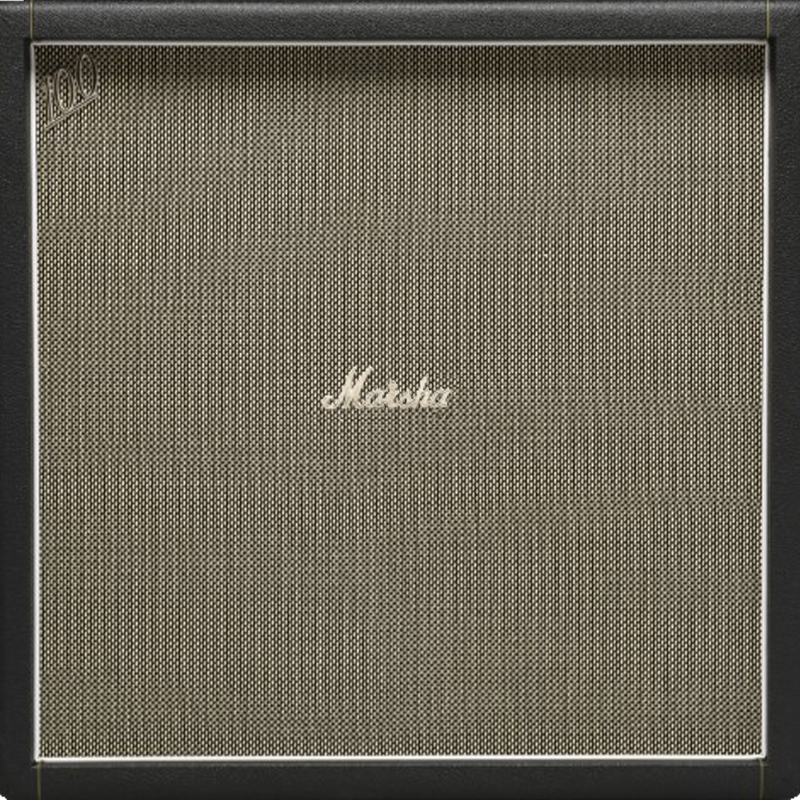Marshall 1960BHW 4×12 Guitar Cabinet
The origin of the 3-tier stack amplifier.
4 x 12 cabinet released in conjunction with the 1959 Plexi from top amp maker Marshall. It is designed to be placed at the bottom of a so-called 3-tier stack, where the head and two cabinets are stacked, and mainly focuses on the low range. All units are mounted flat on the baffle plate to reproduce the charm of a well-phased, punchy sound.
Marshall 1960BHW Introduction
The UK’s Marshall is on par with America’s Fender. Founder Jim Marshall himself was once a musician and later launched the Marshall Shop as a retailer. Originally it was a drum speciality store, as the number of customers increased, they also began amplifier maintenance.
At the time it was common for guitar amps to break down. Marshall himself decided to create an amp leading to the creation of Marshall JTM-45 on the circuit of Fender Bassman. This was the beginning of the Marshall brand.
In the 1960s, before the establishment of PA systems for live stages like today, the role of instrument amplifiers was also to amplify the sound of instruments on stage. The stack of four cabinets was designed to increase the output of the amp and make the speaker cabinet project the sound farther.
Marshall then created 1959 / 100W amps and 1987 / 50W amps, and in a blink of an eye, guitarists in the United Kingdom and the United States began using them. Their sound is on numerous stages and on famous records. The Treble and Normal channels each have one input (total of four) and the method of crossing two inputs using a patch cable (channel link) was also born in this era to increase the gain.
Then came Marshall’s biggest hit, the JCM800 in 1981. There are several models of the JCM800, which was the transition immediately after 1959 and 1987. It is also a feature of JCM800 that it was subdivided into 2203, 2204, 2205, and 2210 later due to differences in circuit boards. Also, at that time, the PA at the live stage had already evolved and there was no problem as long as the instrument was producing a certain volume, so the Master Volume came to be attached to the amplifier this time.
Around the time of JCM800, guitarists sought a sound that had even more gain. Each guitarist had their unique methods such as boosting with a pedal effector and using a high-power pickup.
Then came JCM900, the successor to the JCM800, equipped with a gain boost circuit in the first stage, making it possible to obtain a gain-boosted sound without using a pedal.

Marshall created the foundation of guitar amps, and many new brands were created by various engineers remodelling Marshall. Marshall is a giant in the guitar amp world, and it can be said that he has built music history with great musicians.
Speaking of Marshall, the 1960 cabinet is the most famous. There are two types of 1960 cabinets: A cabs (slant) and B cabs (straight). As you may know, the slant cabinet has two bottom halves mounted parallel to the baffle plate, while the two top halves are slanted upward. As a result, when a guitarist plays a few meters away from the cab, the sound of the guitar amp will reach the player’s ears, so it can also be used as a monitor.
As the name suggests, all four straights are mounted vertically on the baffle plate.
In addition, if you install the A cab on the top and the B cab on the bottom, and put the amp head on the top, you have an eight-shot cabinet or a Marshall stack. It was an idea that was born before the PA system was established, but after that, it became a symbol of rock and roll, with countless cabinets lined up on the stage.
Dynax CAB IR
DYNAX IR is the ultimate impulse response, created with a focus on how to reproduce a realistic cabinet. DYNAX IR has a lower latency than most IRs, providing a highly responsive and realistic sound.
Dynax CAB IR Introduction
also you can check Sound sample each Guitar Cabiner models on DYNAX IR LIST page.
DYNAX IR LIST Page
we will post latest DYNAX IR news to our Official Instagram.
Please follow us.
DYANX & Theone Official Instagram

